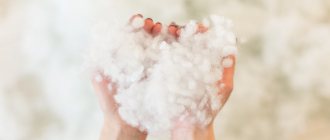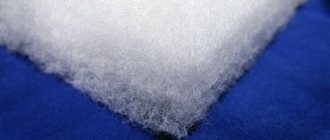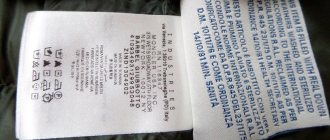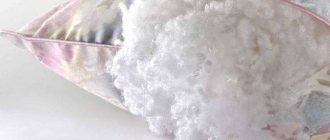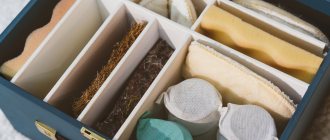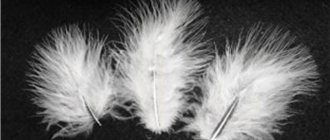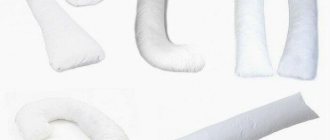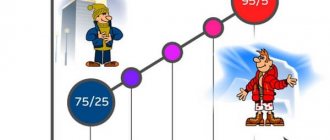Features and production
Synthetic fiber is obtained from melted polyester . The structure of the hollophane is hollow inside. The fibers are shaped into a spiral. The finished product is safe only if it is made from high-quality raw materials. Holophane fabric is a tight weave of fibers that retains and quickly acquires its original appearance. In terms of heat-protective properties, the material resembles natural down.
Depending on the density, there are four groups of insulation (average values):
- Density indicator 125 g/sq.m – holophane is recommended for wearing at temperatures 5–10 degrees above zero;
- The numbers are 175 g/sq.m - the material must be operated in a mode from 5 degrees above zero to 10 degrees below zero;
- Indicator 230 g/sq.m – holophane is used at temperatures from 5 to 25 degrees below zero;
- Finally, the highest option, 325 g/sq.m , is a clothing filler that can withstand temperatures up to 35 degrees cold.
Numerous tests have revealed a relationship between thermal resistance and fiber density . When the density of the material doubles, the first indicator will increase by almost fifty percent. Autumn clothing is characterized by a density of 130–170 g/sq.m, and winter clothing, on average, 230 g/sq.m.
Synthetic material must have all the necessary documents confirming the high quality of the raw materials. When purchasing, you can ask the seller to show a package of papers.
What is holophane filler, its features
Hollophan is a filler made from high quality hollow polyester fiber. The material used has been certified and is completely safe for health. As a result of processing polyester, the fiber is formed into soft elastic springs, giving the filler improved properties.
The material is manufactured with different densities. The higher it is, the greater the frost it can withstand. The standard provides for indicators from +5 to -35 °C.
Holofan is a name derived from two words: “hollow” - “hollow” and “fan” - part of the name of the St. Petersburg factory “Fanema”, which produces the filler.
Varieties
The holophane manufacturer mixes synthetic threads with natural ones. Several production technologies are used , the percentage of fibers and their natural components change.
For example, there is a material with the addition of a quarter
of semi-fine sheep wool .
Both canvases have a hollow structure, so they interact well with each other. Natural material gives the product such properties as breathability and the ability to remove moisture. In addition, sheep wool has some healing effects.
For sewing elements of children's clothing, the company produces siliconized holophane . Silicone makes the material elastic and more durable, increasing its wear resistance.
The strength of the material can be increased by using special gluing of the upper fibers at high temperatures . The result is a dense top layer of fabric. It is able to withstand external factors. Additionally, the fabric is processed at high temperatures. This helps reduce fiber migration.
Performance characteristics and properties
Hollophan has a number of advantages over natural insulation:
- airy, soft, lush;
- retains heat well without letting it out;
- prevents the skin from overheating during prolonged wear;
- returns to its original shape, so it can easily withstand repeated washing and drying;
- instantly removes moisture and sweat thanks to air circulation;
- does not create a greenhouse effect;
- safe non-toxic composition;
- Excellent machine washability;
- does not absorb moisture and odors;
- does not cause allergic reactions;
- budget cost of the finished product.
Hollophan has the property of not collecting microorganisms, which makes it the safest and hypoallergenic material possible . Synthetic threads are resistant to tearing, abrasion, and stretching, which protects the material from external influences. The low weight of holofiber makes the finished garment light and easy to use. At the same time, its strength does not suffer.
The material is very pleasant to the touch. It does not lose its shape, does not fall off or decrease in volume even under adverse weather conditions. Regular wearing of products with synthetic fibers does not affect their appearance . Another important property of holophane is its resistance to alkalis and acids, as well as its calm attitude to sudden changes in environmental temperature.
The disadvantages include the impressive amount of insulation. In terms of this indicator, it cannot be compared with natural material or good old padding polyester.
The material has the following characteristics:
- Moisture capacity is not higher 0,7 %.
- Hollofan is 25% , less wrinkleable by 35% , and recovers faster by 15% .
- Restoring the original shape after loading – 100%.
Properties and composition of the material
In terms of its heat-protective properties, the material is very similar to natural down, but hollowfan has some significant advantages:
- washes very well;
- does not collect moisture and odors;
- does not cause allergies;
- the heat generated by the body is perfectly retained;
- no overheating during constant use;
- Frequent washing and wear are not a problem, as it retains its shape;
- rapid removal of moisture;
- made from non-toxic raw materials.
During production, polyester fibers are mixed with natural ones, such as sheep's wool (30% of this raw material is added). Wool improves thermal insulation, moisture management and breathability, as well as healing properties. Holophane and wool fibers are similar in structure and therefore combine perfectly. In addition, silicone is added to the material, which improves elasticity and elastic properties, which has an even better effect on wear resistance.
Thanks to this composition, the material is very pleasant to the touch, holds its shape, and does not wrinkle under load or washing. Constant compression and stretching, as well as the use of solvents during dry cleaning, are not harmful to holophane. The material is resistant to temperature changes, as well as to acids and alkalis.
The moisture-holding properties of the material do not exceed 0.7%, which means that it can retain its shape during operation even in unfavorable conditions. Holofan will not absorb moisture from rain and sweat; thanks to its porous structure, air will circulate freely, which will remove excess moisture and retain warmth in cold weather.
The insulation capacity of hollophane compared to padding polyester is 25-30% greater, creasing is 30-40% less, and restorative properties are 10-20% greater. After loading, padding polyester restores its shape by 70-80%, and hollophane by 100%.
Application for sewing workwear and other areas
Hollophan is ideal for the production of workwear . In this form, the worker is not constrained in his movements and is protected from the cold even in frosty weather. After cleaning or washing, the product dries in a matter of hours, which saves time and money.
Holofan is used to equip rescuers, State Traffic Inspectorate employees, as well as workers in other specialties related to activities in the cold season.
Hollophan, like other synthetic insulation materials, has found wide application in the domestic sphere . It is used wherever thermal resistance and rapid recovery of shape after load are needed.
In addition to its intended purpose, the material fits perfectly into the process of sewing bedding, as well as stuffing soft toys and furniture.
Sometimes synthetic material finds unexpected uses. Some motorists install a subwoofer in the car and use holophane to fill it . This is done in order to improve the sound.
We will tell you in the next review what materials and fillers are used in the production of winter camouflage clothing.
Find out where thermofin insulation is used here.
Read about the performance properties of shelter insulation in this article.
Where is holophane used?
The range of applications of holophane is wide. It is used
- at home;
- in construction;
- furniture production;
- when sewing textile products (clothing, bedding).
The material is rarely used in households, furniture production and construction. Hollophan is not the cheapest synthetic insulation. More often it is used when sewing warm clothes, workwear, pillows, blankets, and for stuffing children's soft toys.
Clothes with holofan, including children's (the material is absolutely safe), are produced in two types: demi-season and winter. Depending on the density of the filler used, it is suitable for +5 °C (125 g/m2), but can withstand -35 °C (325 g/m2).
Bedding with holofan is a product that can provide a healthy, comfortable sleep and complete restoration of strength. The pillows are different
- softness;
- elasticity;
- the ability to quickly restore shape;
- wear resistant.
Blankets are appreciated
- for excellent thermal insulation;
- softness;
- breathability;
- lightness, fluffiness.
The material has found application in the production of tourism goods: suits, sleeping bags.
Average prices, care features
Products with holophane are practical to use and versatile:
- Compared to natural filler, synthetic fibers do not bunch up or wrinkle when washed . It is allowed to wash clothes in an automatic machine at a temperature of 30–40 degrees.
- Spinning is allowed, but not recommended . The maximum drying speed in the drum is 500 rpm.
- It is better to dry a clean item of clothing on a hanger. This way it will quickly take its initial shape. It is prohibited to use heaters or radiators for drying . Dry cleaning allowed.
Holofan has an affordable price. The average price of one kilogram of hollophane is 200–250 rubles. It is more profitable to purchase synthetic insulation in bulk.
Reviews about the application
- Dmitry, Lipetsk : “Hollofan is much better than padding polyester. I bought workwear last year, the fillings were synthetic fibers. Worn in both cold and warm weather. I only froze once when I stood still for a long time and didn’t move.”
- Gleb, Dnepropetrovsk : “The insulation is hypoallergenic, that’s the only reason I bought my suit.
I am a terrible allergy sufferer; I have an individual intolerance to natural fillers. I’m not afraid to wash clothes; I don’t need any tennis balls. The fibers don’t bunch up.” - Leonid, Minsk : “Holofan retains heat well, even if it gets wet.
I tested this property for myself. It turned out that a bucket of cold water was poured on me while I was working (I wash windows in high-rise buildings), so not only did I not catch a cold, but I didn’t even freeze.” - Roman, Nizhny Novgorod : “My work jacket is stuffed with holofan. I work outdoors, but not every day. With the new special uniform, I forgot what the word “freeze” is. Particularly comfortable at medium temperatures.”
